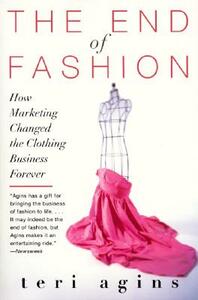Take a photo of a barcode or cover
informative
medium-paced
The title of this book and its back cover don't accurately describe it. I would call it a collection of vignettes describing the transformation of "high fashion" from the couture Parisian-based designers to the publicly traded Ralph Lauren/Donna Karans of the '90's. I really enjoyed the access that the author gives to the closed-off world of fashion. It was fun to imagine what it would have been like to shop at Marshall Field's in the 19th century, or to be in the design studio with Emanuel Ungaro, or to hang out with Tommy Hilfiger's celebrity supporters in the '90's. The book was very dish-y in a fun way, especially for fashion lovers. I was also fun to revisit the '90's. The author's conclusions are a bit off, but the stories she tells are great.
I would give this book a higher rating if only it was up-to-date.
I learned so much about several designer brands and their respective histories. This book has really stepped up my fashion knowledge and I hope to read similar books in the future.
I learned so much about several designer brands and their respective histories. This book has really stepped up my fashion knowledge and I hope to read similar books in the future.
Truly impressed with the breadth of research that went into this work. The first third of the book is about classic designers like Dior and Chanel and their workrooms centered in Paris in the late 60s. The second third focuses on modern designers like Tommy Hilfiger and Ralph Lauren - exploring how their causal style could possibly take over the reigns from the likes of Dior. The last third explores the inner workings of fashion in department stores and how so many large stores failed and why.
The combination of retail insight and fashion history was irresistible for me. Well researched with personal interviews conducted by the author, the writing is engaging but doesn't attempt to speak above the reader with insider lingo.
My favorite section was about Zoran Ladicorbic, the Serbian fashion designer who made his name making simple clothes in a very limited range of sizes in the very best fabrics imported from Europe. He avoided the pitfalls of over growth by being focused on maintaining his high standards for a limited client base.
I wish the book had a larger section of images. There are only 5 pages of glossy black and white photos. The ones selected don't make logical sense for what the author had described throughout the pages. I feel that if you spend a chunky paragraph describing a garment or a magazine advertisement, those should be the featured images. The images selected were random pictures of designers in their studios, which did not add to the comprehension of the ideas presented.
The combination of retail insight and fashion history was irresistible for me. Well researched with personal interviews conducted by the author, the writing is engaging but doesn't attempt to speak above the reader with insider lingo.
My favorite section was about Zoran Ladicorbic, the Serbian fashion designer who made his name making simple clothes in a very limited range of sizes in the very best fabrics imported from Europe. He avoided the pitfalls of over growth by being focused on maintaining his high standards for a limited client base.
I wish the book had a larger section of images. There are only 5 pages of glossy black and white photos. The ones selected don't make logical sense for what the author had described throughout the pages. I feel that if you spend a chunky paragraph describing a garment or a magazine advertisement, those should be the featured images. The images selected were random pictures of designers in their studios, which did not add to the comprehension of the ideas presented.
I find the business of fashion quite interesting, even though I'm not particularly interesting in fashion per se. But I hadn't realized quite how old this book, so it was an odd read.
informative
medium-paced


